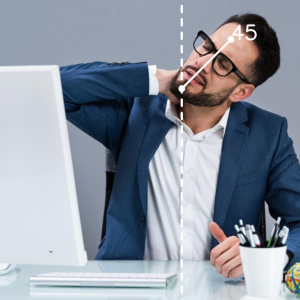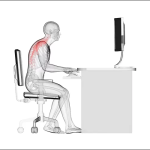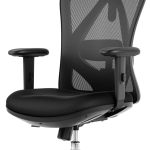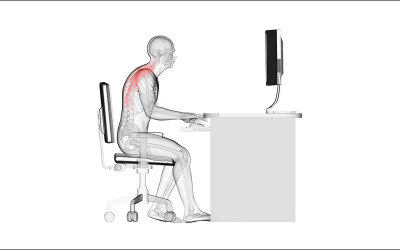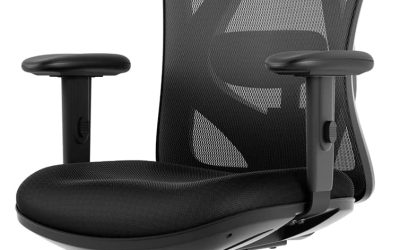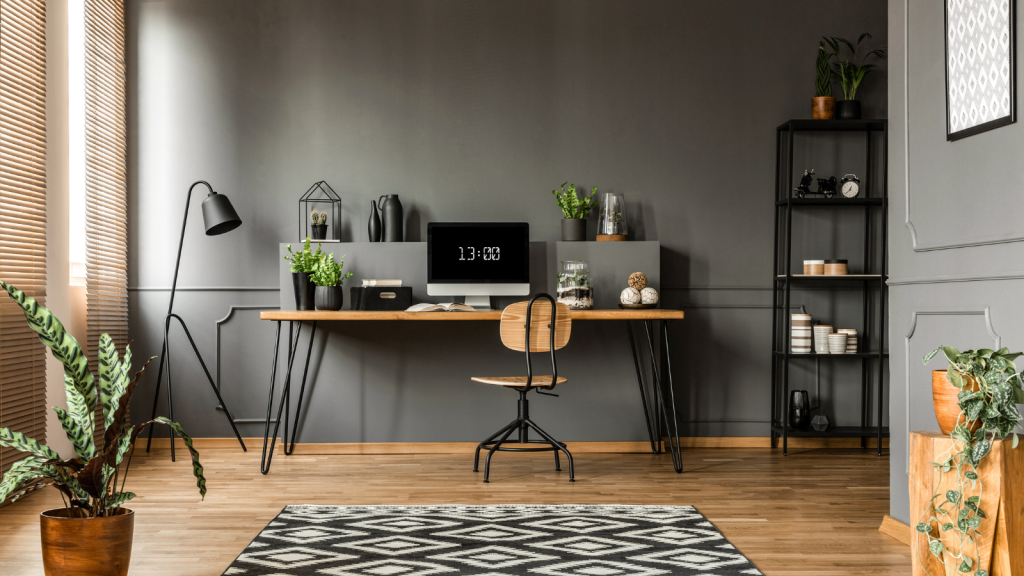
Spending hours a day at a computer can cause health problems down the line, however, lack of productivity is one of the biggest concerns that leads to stress, anxiety, and potentially losing your sources of income. Neck pain is one of the most common dis-eases that we have today, and your home office could be the leading contributor. Early onset of neck pain includes strains and aches, reducing the amount of time you can be productive in the day, lowering your energy levels, and cripples your posture.
Ergonomics Tips for Working at Home
Chair to support your spine
Chair: For working, a strong chair that supports the spine curve is preferable. Additionally, chairs should have adjustments so that your thighs are parallel to the floor and your feet can rest level on them.
Your arms should also be parallel to the floor as you type. Find a chair that is comfortable for you and that supports your back in both an upright and slightly reclined posture.
Protect your wrists
Your wrists and elbows can become sore from working at kitchen tables or other hard surfaces. University of Cincinnati environmental health professor Kermit Davis advises placing a soft cloth on the table so you can rest your wrists. The ideal wrist position is parallel to your workplace.
Don’t work in Bed
Working from your couch or bed for more than an hour a day is not ergonomic or healthy, despite how convenient it may appear. The ability to distinguish between work and rest can help the mind recognize the difference and stay focused. Having a designated workstation outside the bedroom allows for proper working posture.
No slouching at the Laptop
Slouching while using a computer for more than 40 hours a week can cause back, shoulder, and neck pain, and doing so for a few hours on the weekend is not recommended. If possible, prop up your screen with an extra monitor or laptop stand (along with an external keyboard and mouse). Your eye line should be level with the address bar of your web browser when looking at the screen.
Take posture breaks every 30 minutes
Don’t forget to stand up and move around: Employees should refrain from sitting at their desks for more than eight hours, even at work. It also holds for remote work. Take frequent breaks to get up, stretch, and do a few light movements.
Ergonomic basics when working from home
Making your home office ergonomically sound frequently requires minor changes. Several recommendations are:
- To avoid tilting or hyper-flexing your neck, keep your screen level with your eyes.
- To prevent shoulder pain, bring your laptop or keyboard closer to you.
- Spend money on a suitable chair.
- Ensure that your workstation is the ideal height for you.
- Use an anti-glare screen protector to reduce eye strain and safeguard your eyes.
- Set up your supplies so all can be within arm’s reach (thereby ensuring the economy of movement).
The 20 – 20 – 20 Formula will save your eyes
After 20 minutes screen time – Look at something 20 feet away – for 20 seconds
Working from home ergonomics involves more than just setting up the proper furniture and calibrating your equipment. There are other approaches to working effectively. These approaches enhance your general wellness.
After 20 minutes of screen usage, the 20-20-20 rule advises looking at something 20 feet away for 20 seconds.
When working from home, it’s crucial to remember to take regular screen breaks and include movement in your day. Exercises like walks, stretching, or even using a sit-stand desk can be beneficial.
The 20-20-20 rule recommends taking a 20-second recess every 20 minutes from staring at a screen. Focusing on something at least 20 feet away during the break helps to relax the eye muscles.
This principle can be put into practice using the following techniques:
- While working, set the alarm every 20 minutes to remind you to take a break.
- A 20-foot distance can be challenging to judge. However, focusing on something more than 20 feet away also helps. When in doubt, try to cover a greater distance than you normally would.
- During the 20-second breaks, if there is a window nearby, look out it. Outside, it might be simpler to locate a far-off item.
- Install a mobile app created to make it easier to follow the 20-20-20 rule. The National Keratoconus Foundation lists EyePro and Awareness as possibilities.
- Additionally, keeping your eyes moistened by remembering to blink might help avoid dry eyes.
- To avoid back and neck aches, someone who spends the day sitting down should occasionally get up and move around.
The importance of home ergonomics
The musculoskeletal system may be impacted at work when the body is under stress from an inconvenient posture, a hot environment, or repeated movements. Therefore, ergonomics is crucial in preventing work-related illnesses and injuries such as carpal tunnel syndrome, neck and back pain, and computer vision syndrome.
- To design a safe, pleasant, and productive workspace while also considering human constraints and capabilities, such as physical size, strength, skill, speed, attitudes, and sensory capacities.
- To boost productivity and comfort among staff.
Benefits of a good desk and chair at home
- Decreased risk of illnesses and accidents at work
- Increased productivity
- Enhanced health
- Enhanced mental clarity
- A higher standard of the goods
- Reduced pain
- Increased employee happiness and engagement, improved safety culture
Hazard Avoidance
In addition to setting up your workstation correctly, you should be aware of potential new danger factors. Avoid overloading electrical outlets or posing tripping hazards in your home by running extension cables or power strips across the floor.
Conclusion
Home office use has advantages and disadvantages. Even while working from home may not be ideal, following the advice in this article can help significantly reduce the likelihood of avoidable accidents.
